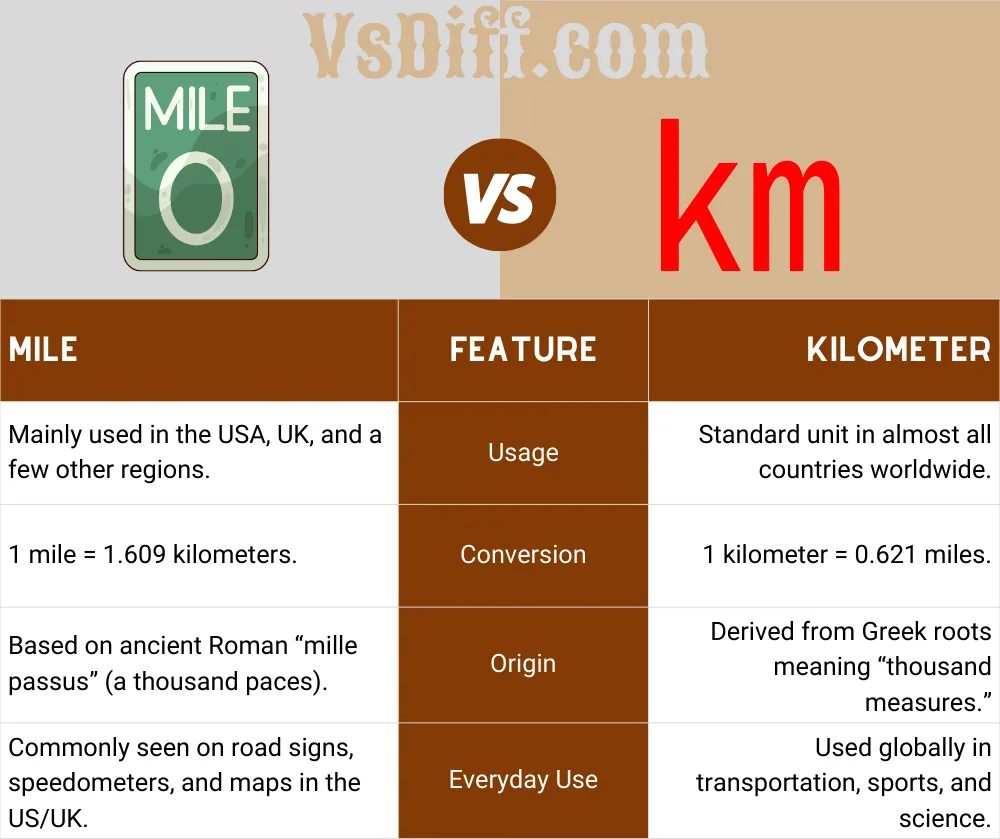Real-Life Examples: Mile vs Kilometer
To better understand how miles and kilometers compare, here are some everyday examples that put the numbers into perspective:
- A standard marathon: 26.2 miles ≈ 42.195 kilometers.
- A 5K race: 5 kilometers ≈ 3.1 miles.
- Driving distance New York City to Washington, D.C.: about 225 miles ≈ 362 kilometers.
- London to Manchester: 210 kilometers ≈ 130 miles.
- A football field (US): 100 yards ≈ 0.057 miles ≈ 0.091 kilometers.
- Average human walking pace: 3 miles per hour ≈ 4.8 kilometers per hour.
These comparisons make it easier to convert between miles and kilometers in daily life, whether you’re running, driving, or traveling abroad.
Mile vs Kilometer: Detailed Comparison
When it comes to measuring distance, miles and kilometers are the two most common units. While miles dominate in the United States and the United Kingdom, kilometers are standard across most of the globe. This guide explores their origins, conversions, and where each is commonly used.
| Mile | Feature | Kilometer |
|---|---|---|
| Mainly used in the USA, UK, and a few other regions. | Usage | Standard unit in almost all countries worldwide. |
| 1 mile = 1.609 kilometers. | Conversion | 1 kilometer = 0.621 miles. |
| Based on ancient Roman “mille passus” (a thousand paces). | Origin | Derived from Greek roots meaning “thousand measures.” |
| Commonly seen on road signs, speedometers, and maps in the US/UK. | Everyday Use | Used globally in transportation, sports, and science. |
Conversion Formula
From Miles to Kilometers: Km = Miles × 1.609 From Kilometers to Miles: Miles = Km × 0.621
Historical Timeline
- Ancient Rome: The mile was created as 1,000 paces.
- 18th Century: The metric system introduced in France.
- 19th Century: Kilometers spread across Europe and beyond.
- 20th Century: Most countries fully adopted the kilometer.
- Present Day: Only a handful of nations still use miles.
Pros and Cons
- Miles Pros: Deep historical roots, familiar in the US/UK.
- Miles Cons: Not globally standardized, harder to convert.
- Kilometers Pros: Universally accepted, aligns with science and international trade.
- Kilometers Cons: May feel unfamiliar in mile-using regions.
Summary
Both miles and kilometers are practical, but their relevance depends on geography. Kilometers dominate globally as part of the metric system, while miles continue to carry cultural and traditional importance in a few regions.
FAQ: Mile vs Kilometer
Which countries still use miles?
The USA, UK, and a few smaller regions continue to rely on miles for road distances.
Which is longer, a mile or a kilometer?
A mile is longer than a kilometer. One mile equals about 1.609 kilometers.
Why are kilometers more common worldwide?
Kilometers are part of the metric system, which is the international standard for science, trade, and travel.
Do athletes run in miles or kilometers?
International events like marathons are measured in kilometers, but some US-based sports still use miles.
